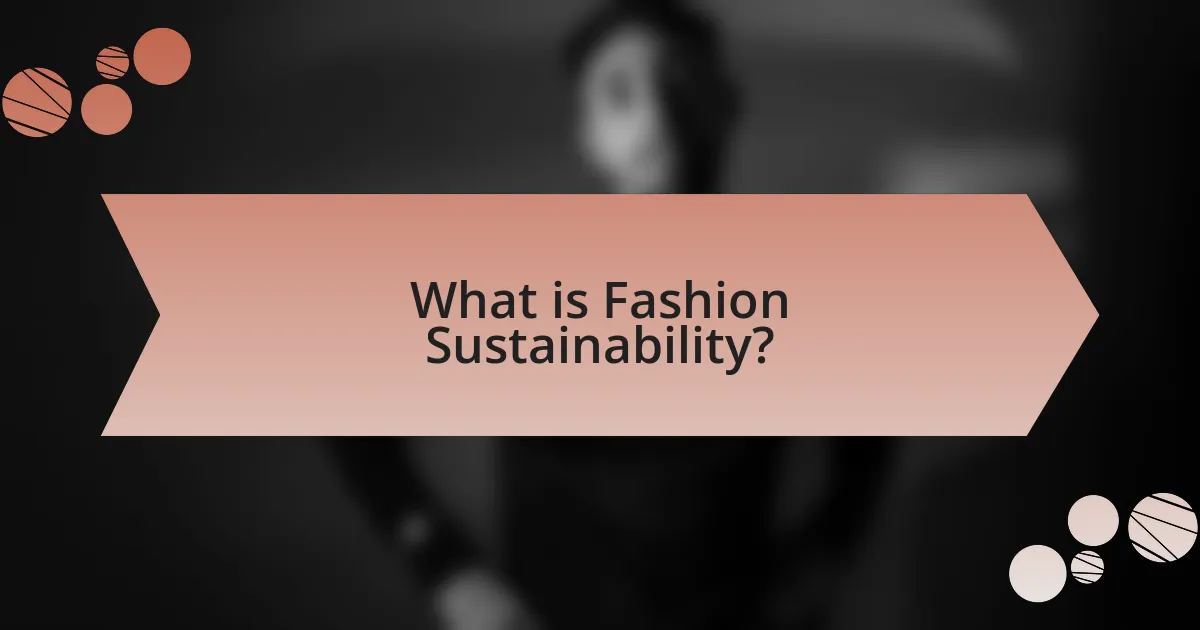Fashion sustainability is the practice of designing, producing, and consuming clothing in a manner that minimizes environmental impact and promotes social responsibility. This article explores the significance of sustainable practices in the fashion industry, highlighting the urgent need to address issues such as carbon emissions, waste management, and ethical labor. It examines key principles of sustainability, contrasts them with traditional fashion practices, and identifies leading brands like Patagonia and Stella McCartney that exemplify ethical practices. Additionally, the article discusses how consumer behavior is shifting towards sustainability, the role of second-hand shopping, and practical tips for supporting sustainable fashion.

What is Fashion Sustainability?
Fashion sustainability refers to the practice of designing, producing, and consuming clothing in a way that minimizes environmental impact and promotes social responsibility. This concept encompasses various strategies, such as using eco-friendly materials, reducing waste through recycling and upcycling, and ensuring fair labor practices throughout the supply chain. According to the Global Fashion Agenda’s 2021 report, the fashion industry is responsible for 10% of global carbon emissions, highlighting the urgent need for sustainable practices to mitigate climate change and promote ethical consumption.
How does Fashion Sustainability impact the industry?
Fashion sustainability significantly impacts the industry by driving brands to adopt ethical practices that reduce environmental harm and promote social responsibility. This shift is evidenced by the increasing number of companies committing to sustainable materials, with a report from McKinsey & Company indicating that 67% of consumers consider sustainability when making a purchase. Furthermore, brands that prioritize sustainability often experience enhanced brand loyalty and market differentiation, as seen with companies like Patagonia and Stella McCartney, which have successfully integrated eco-friendly practices into their business models. This trend not only influences consumer behavior but also encourages innovation in sustainable technologies and practices across the fashion supply chain.
What are the key principles of Fashion Sustainability?
The key principles of Fashion Sustainability include ethical sourcing, resource efficiency, waste reduction, and social responsibility. Ethical sourcing ensures that materials are obtained from suppliers who adhere to fair labor practices and environmental standards. Resource efficiency focuses on minimizing the use of water, energy, and raw materials throughout the production process. Waste reduction emphasizes strategies such as recycling, upcycling, and designing for longevity to decrease textile waste. Social responsibility involves ensuring fair treatment and safe working conditions for all individuals involved in the fashion supply chain. These principles are supported by various industry standards and certifications, such as the Global Organic Textile Standard (GOTS) and the Fair Trade certification, which validate the commitment to sustainable practices.
How does Fashion Sustainability differ from traditional fashion practices?
Fashion sustainability focuses on minimizing environmental impact and promoting ethical labor practices, contrasting with traditional fashion practices that often prioritize profit and rapid production. Sustainable fashion emphasizes the use of eco-friendly materials, waste reduction, and fair labor conditions, while traditional fashion frequently relies on fast fashion models that contribute to pollution and exploitative labor. For instance, the Ellen MacArthur Foundation reports that the fashion industry is responsible for 10% of global carbon emissions, highlighting the urgent need for sustainable practices to mitigate such impacts.
Why is Fashion Sustainability important today?
Fashion sustainability is important today because it addresses the environmental and social impacts of the fashion industry, which is one of the largest polluters globally. The production of clothing contributes to significant waste, with an estimated 92 million tons of textile waste generated annually, and the industry is responsible for about 10% of global carbon emissions. Sustainable practices, such as using eco-friendly materials and ethical labor practices, help mitigate these issues, promoting a healthier planet and fairer working conditions. Brands that adopt sustainable practices not only reduce their ecological footprint but also respond to increasing consumer demand for transparency and responsibility in fashion, as evidenced by a 2021 McKinsey report indicating that 67% of consumers consider sustainability when making a purchase.
What environmental issues does Fashion Sustainability address?
Fashion sustainability addresses several critical environmental issues, including waste management, resource depletion, and pollution. The fashion industry is responsible for approximately 92 million tons of waste annually, much of which ends up in landfills. Additionally, the production of textiles consumes vast amounts of water, with the industry using around 93 billion cubic meters of water each year, contributing to water scarcity. Furthermore, the use of harmful chemicals in dyeing and finishing processes leads to significant water pollution, affecting ecosystems and human health. These issues highlight the urgent need for sustainable practices in fashion to mitigate environmental impact.
How does Fashion Sustainability affect consumer behavior?
Fashion sustainability significantly influences consumer behavior by increasing demand for ethically produced clothing. Consumers are increasingly prioritizing sustainability, with 66% of global respondents in a Nielsen survey stating they are willing to pay more for sustainable brands. This shift is driven by heightened awareness of environmental issues and social responsibility, leading consumers to favor brands that demonstrate commitment to sustainable practices. Additionally, studies show that 73% of millennials are willing to pay extra for sustainable products, indicating a generational trend towards valuing ethical consumption.

Which Brands are Leading in Fashion Sustainability?
Patagonia, Stella McCartney, and Eileen Fisher are leading brands in fashion sustainability. Patagonia is renowned for its commitment to environmental activism and the use of recycled materials, with over 69% of its products made from recycled fabrics. Stella McCartney emphasizes cruelty-free fashion and sustainable sourcing, being a pioneer in vegan leather alternatives. Eileen Fisher focuses on circular fashion, implementing take-back programs and using organic fibers, with 60% of its collection made from sustainable materials. These brands exemplify ethical practices and set benchmarks in the industry for sustainability.
What are some notable examples of sustainable fashion brands?
Notable examples of sustainable fashion brands include Patagonia, Eileen Fisher, and Reformation. Patagonia is recognized for its commitment to environmental activism and using recycled materials in its products. Eileen Fisher focuses on organic and sustainable fabrics, promoting fair labor practices and circular fashion through its take-back program. Reformation emphasizes eco-friendly practices, transparency in sourcing, and has a strong commitment to reducing its carbon footprint. These brands exemplify leadership in ethical practices within the fashion industry.
How do these brands implement sustainable practices?
Brands implement sustainable practices by adopting eco-friendly materials, reducing waste, and promoting ethical labor standards. For instance, many fashion brands utilize organic cotton, recycled polyester, and biodegradable fabrics to minimize environmental impact. Additionally, brands often implement circular economy principles, such as take-back programs and recycling initiatives, to reduce waste. According to a 2021 report by McKinsey & Company, sustainable practices in fashion can reduce greenhouse gas emissions by up to 30% if widely adopted. Furthermore, brands are increasingly transparent about their supply chains, ensuring fair labor practices and compliance with environmental regulations, which enhances their commitment to sustainability.
What certifications or standards do these brands adhere to?
Brands in the fashion sustainability sector typically adhere to certifications and standards such as Global Organic Textile Standard (GOTS), Fair Trade Certified, and OEKO-TEX Standard 100. GOTS ensures organic status of textiles, Fair Trade Certified promotes fair labor practices, and OEKO-TEX Standard 100 guarantees that textiles are free from harmful substances. These certifications validate the brands’ commitment to ethical practices and sustainability in their production processes.
Why do certain brands stand out in their sustainability efforts?
Certain brands stand out in their sustainability efforts due to their commitment to transparency, innovative practices, and measurable impact. For instance, brands like Patagonia and Stella McCartney have established themselves as leaders by integrating sustainable materials, such as organic cotton and recycled polyester, into their products. Patagonia’s “Worn Wear” program promotes the repair and reuse of clothing, reducing waste and encouraging a circular economy. Additionally, Stella McCartney’s use of vegan leather alternatives and commitment to ethical sourcing exemplifies a proactive approach to sustainability. These brands not only implement eco-friendly practices but also communicate their efforts effectively, fostering consumer trust and loyalty.
What innovative practices are these brands adopting?
Brands in the fashion industry are adopting innovative practices such as circular fashion, which emphasizes recycling and reusing materials to minimize waste. For instance, companies like Stella McCartney utilize sustainable materials and promote a take-back program for their products, allowing customers to return items for recycling. Additionally, brands like Patagonia implement repair and resale initiatives, encouraging consumers to extend the life of their garments. These practices are supported by research indicating that the circular economy can reduce fashion’s environmental impact by up to 80% in terms of resource consumption and waste generation.
How do these brands communicate their sustainability efforts to consumers?
Brands communicate their sustainability efforts to consumers through transparent marketing, eco-labeling, and storytelling. For instance, many fashion brands utilize social media platforms to share their sustainable practices, such as using organic materials or reducing carbon footprints, which helps build trust and awareness among consumers. Additionally, certifications like Fair Trade or Global Organic Textile Standard (GOTS) are prominently displayed on products, providing consumers with verifiable proof of the brand’s commitment to sustainability. Research indicates that 66% of global consumers are willing to pay more for sustainable brands, highlighting the effectiveness of these communication strategies in influencing purchasing decisions.

How can consumers support Fashion Sustainability?
Consumers can support fashion sustainability by choosing to purchase from brands that prioritize ethical practices and sustainable materials. By selecting clothing made from organic, recycled, or eco-friendly materials, consumers directly influence demand for sustainable products. Research indicates that the global sustainable fashion market is expected to reach $8.25 billion by 2023, highlighting a growing consumer preference for sustainable options. Additionally, consumers can extend the life of their garments through proper care, repair, and recycling, which reduces waste and environmental impact. Engaging in second-hand shopping also contributes to sustainability by promoting circular fashion, as it decreases the need for new production.
What choices can consumers make to promote sustainable fashion?
Consumers can promote sustainable fashion by choosing to buy from brands that prioritize ethical practices, such as using eco-friendly materials and ensuring fair labor conditions. By supporting companies that implement sustainable production methods, consumers contribute to reducing environmental impact and promoting social responsibility. Research indicates that the fashion industry is responsible for 10% of global carbon emissions, highlighting the importance of consumer choices in driving demand for sustainable alternatives. Additionally, consumers can opt for second-hand clothing, which extends the lifecycle of garments and reduces waste, further supporting sustainability in fashion.
How does purchasing from sustainable brands impact the market?
Purchasing from sustainable brands positively impacts the market by driving demand for eco-friendly products and encouraging companies to adopt ethical practices. This shift in consumer behavior leads to increased sales for sustainable brands, which in turn influences traditional brands to improve their sustainability efforts to remain competitive. For instance, a report by Nielsen indicates that 66% of global consumers are willing to pay more for sustainable brands, demonstrating a clear market trend towards sustainability. Additionally, as more consumers prioritize sustainability, investments in sustainable practices can lead to long-term profitability and market growth for these brands.
What role does second-hand shopping play in Fashion Sustainability?
Second-hand shopping significantly contributes to fashion sustainability by extending the lifecycle of garments and reducing waste. This practice minimizes the demand for new clothing production, which is responsible for substantial environmental impacts, including water consumption and carbon emissions. According to a report by the Ellen MacArthur Foundation, the fashion industry is responsible for 10% of global carbon emissions, and second-hand shopping can help mitigate this by promoting reuse. Additionally, purchasing second-hand items diverts textiles from landfills; the Environmental Protection Agency states that in 2018, 11.3 million tons of textile waste were generated in the U.S. alone. Thus, second-hand shopping plays a crucial role in fostering a more sustainable fashion ecosystem by promoting circularity and reducing the overall environmental footprint of the industry.
What are some practical tips for embracing sustainable fashion?
To embrace sustainable fashion, individuals should prioritize buying from ethical brands that use eco-friendly materials and fair labor practices. Research indicates that the fashion industry is responsible for 10% of global carbon emissions, highlighting the importance of making conscious choices. Consumers can also opt for second-hand clothing, which reduces waste and extends the lifecycle of garments. Additionally, practicing mindful consumption by purchasing only what is necessary and investing in high-quality, timeless pieces can significantly decrease environmental impact. Engaging in clothing swaps and supporting local artisans further promotes sustainability within the fashion ecosystem.
How can consumers identify truly sustainable brands?
Consumers can identify truly sustainable brands by examining their transparency, certifications, and supply chain practices. Brands that openly share information about their sourcing, production processes, and environmental impact demonstrate a commitment to sustainability. Certifications such as Fair Trade, GOTS (Global Organic Textile Standard), and B Corp status provide credible validation of a brand’s ethical practices. Additionally, consumers should look for brands that prioritize eco-friendly materials, ethical labor practices, and initiatives aimed at reducing waste. Research indicates that brands with these attributes are more likely to engage in sustainable practices, as evidenced by a 2021 report from McKinsey & Company, which found that 67% of consumers consider sustainability when making purchasing decisions.
What are the benefits of investing in sustainable fashion items?
Investing in sustainable fashion items offers environmental, social, and economic benefits. Environmentally, sustainable fashion reduces waste and pollution by utilizing eco-friendly materials and ethical production processes, which can significantly lower carbon footprints. Socially, it promotes fair labor practices and supports local communities, ensuring that workers receive fair wages and safe working conditions. Economically, sustainable fashion can lead to long-term savings for consumers through durable products that outlast fast fashion items, which often require frequent replacement. According to a report by the Global Fashion Agenda, the fashion industry could reduce its greenhouse gas emissions by 30% by 2030 through sustainable practices, highlighting the potential impact of investing in this sector.
